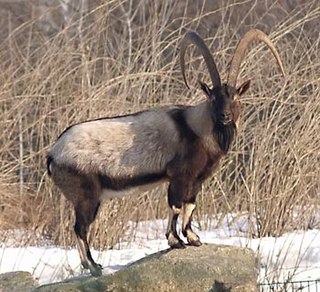 W
WThe Himalayan brown bear, also known as the Himalayan red bear, isabelline bear or Dzu-Teh, is a subspecies of the brown bear and is known from northern Afghanistan, northern Pakistan, northern India, west China and Nepal. It is the largest mammal in the region, males reaching up to 2.2 m (7 ft) long while females are a little smaller. These bears are omnivorous and hibernate in a den during the winter. While the brown bear as a species is classified as Least Concern by the IUCN, this subspecies is highly endangered and populations are dwindling. It is Endangered in the Himalayas and Critically Endangered in Hindu Kush.
 W
WThe Tibetan fox, also known as Tibetan sand fox, is a species of true fox endemic to the high Tibetan Plateau, Ladakh plateau, Nepal, China, Sikkim, and Bhutan, up to altitudes of about 5,300 m (17,400 ft). It is listed as Least Concern in the IUCN Red List, on account of its widespread range in the Tibetan Plateau's steppes and semi-deserts.
 W
WThe Kashmir gray langur is an Old World monkey, one of the langur species. It is a leaf-eating monkey.
 W
WThe snow leopard, also known as the ounce, is a large cat native to the mountain ranges of Central and South Asia. It is listed as Vulnerable on the IUCN Red List because the global population is estimated to number less than 10,000 mature individuals and is expected to decline about 10% by 2040. It is threatened by poaching and habitat destruction following infrastructural developments. It inhabits alpine and subalpine zones at elevations from 3,000 to 4,500 m, ranging from eastern Afghanistan, the Himalayas and the Tibetan Plateau, to southern Siberia, Mongolia, and western China. In the countries in the northern part of its range, it also lives at lower elevations.
 W
WThe Turkestan lynx is a subspecies of Eurasian lynx native to Central Asia. It is also known as Central Asian lynx, Tibetan lynx or Himalayan lynx. It is widespread from west in Central Asia, from South Asia to China and Mongolia. There are 27,000 mature individuals in China as of 2013. It is proposed for the Turkestan lynx to be listed as Vulnerable in Uzbekistan.
 W
WParnassius actius, also known as the scarce red apollo, is a high-altitude butterfly found in Central Asia. It is a member of the snow Apollo genus (Parnassius) of the swallowtail family (Papilionidae).
 W
WThe Kashmir stag, also called hangul, is a subspecies of elk native to Kashmir. It is found in dense riverine forests in the high valleys and mountains of the Kashmir Valley and northern Chamba district in Himachal Pradesh. In Kashmir, it is found in the Dachigam National Park where it receives protection but elsewhere it is more at risk. In the 1940s, the population was between 3000 and 5000 individuals, but since then habitat destruction, over-grazing by domestic livestock and poaching have reduced population dramatically. Earlier believed to be a subspecies of red deer, a number of mitochondrial DNA genetic studies have revealed that the hangul is part of the Asian clade of the elk. The IUCN, however, includes it in the new grouping of Central Asian red deer, with the Kashmir stag being the type subspecies. According to the census in 2019, there were only 237 Hanguls.
 W
WThe wild goat is a wild goat species, inhabiting forests, shrublands and rocky areas ranging from Turkey and the Caucasus in the west to Turkmenistan, Afghanistan and Pakistan in the east. It has been listed as near threatened on the IUCN Red List and is threatened by destruction and degradation of habitat.
 W
WThe Zaniskari or Zanskari is a breed of small mountain horse or pony from Ladakh, in northern India. It is named for the Zanskar valley or region in Kargil district. It is similar to the Spiti breed of Himachal Pradesh, but is better adapted to work at high altitude. Like the Spiti, it shows similarities to the Tibetan breeds of neighbouring Tibet. It is of medium size, and is often grey in colour. The breed is considered endangered, as there are only a few hundred alive today, and a conservation programme has been started in India.